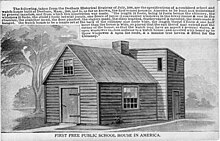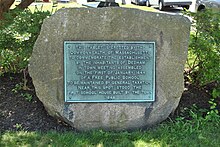History of education in Dedham, Massachusetts
On January 1, 1644, by unanimous vote, Dedham authorized the first U.S. taxpayer-funded public school; "the seed of American education.
[2] John Thurston was commission by the town to build the first schoolhouse in 1648 for which he received a partial payment of £11.0.3 on December 2, 1650.
The details in the contract require him to construct floorboards, doors, and "fitting the interior with 'featheredged and rabbited' boarding" similar to that found in the Fairbanks House.
[4] Residents were content to allow the minister to be the local intellectual and did not establish a grammar school as required by law.
Governor Roger Wolcott led a committee that heard the claims of several cities and towns, including the presentation made by Dedham's Don Gleason Hill and Rev.
[13] The building likely resembled contemporary schools in the English countryside with a raised platform, wooden wainscoting, and high windows.
[15] The early residents of Dedham were so committed to education that they donated £4.6.6 to Harvard College during its first eight years of existence, a sum greater than many other towns, including Cambridge itself.
[17] On January 2, 1643, the Town Meeting set aside land for three public purposes: a school, a church, and a training field.
[18][10] Two years later, on January 1, 1645, by unanimous vote, the Town of Dedham authorized the first taxpayer-funded public school in the United States.
[23] Initially held in the village center, the school began travelling around town as families moved to outlying areas.
[23] Many schools were built in the years following 1897, and were adorned through purchase and donation with a number of works of art.
[25] As early as 1827 the Commonwealth of Massachusetts required all towns with more than 500 families to establish a free public high school.
[30] In that year the town appropriated money for kindergartens at the Ames, Avery, and Oakdale Schools, but they did not last long.
[23] As they had their own farms to manage in addition, their pay was not docked unless they missed an entire week's worth of classes.
[29] His successors through 1936 include Abner J. Phipps, Henry E. Crocker, Guy Channel, Oscar S. Williams, Roderick W. Hine,[a] and John C.
For every boy between the ages of four and 14, a tax of between three-and-a-half to five shillings was assessed,[9] depending on how far from the school the family lived.
[7] Records show that teachers were given the honorary title of "sir" at a time when most men were not even referred to as "mister.
[40] The property was sold to them[b] for $1 by Martin Bates who, out of a "spirit of vindictiveness," gave it to the Sisters because the Town of Dedham would not purchase the run down building from him at his asking price.
[42][43][44][45][46] Bates, who was not Catholic, had previously tried selling the building at auction, but could find no buyer willing to pay a price equal to his mortgage.
[47] At news of the sale, the Dedham Gazette wrote in an editorial: Whatever prejudices may naturally exist against the establishment of a Roman Catholic School in so central a location, the community cannot but feel that the transformation of a building recently used only for the indiscriminate sale of liquors into an institution founded for 'promoting virtue, learning and piety in the town of Dedham' is an object worthy only of the most exalted motives, and in this view should be accepted as a public blessing.
[47]The school was situated far away from the homes of many parishioners of the local Catholic Church, St. Mary's, and thus they did not send their children to it.
Robert J. Johnson, pastor of St. Mary's Church, the parish purchased a large lot of land to one day be used as a school.
[48][53] Several decades later, a parochial school was started in 1932 by Father George P. O'Connor and run by the Sisters of St.
The Boston Globe has praised Ursuline's athletes, the Bears, as winning the Singelais Award for maintaining a 3.0 GPA or higher and excelling in their chosen activity.
[63] The ciborium was originally used by the French Navy in the 1700s and eventually was given to a Boston priest, possibly Bishop Jean-Louis Lefebvre de Cheverus.
[63] It eventually made its way into the Boston College archives before being returned to Ursuline Academy for the transfer of sponsorship.
[65] It changed its name to the Dedham Country Day School in 1930 and the cornerstone of the present building was laid on Sandy Valley Road in 1949.
[69] The Society of African Mission's American Province was established in 1941 amidst significant growth in vocations.
[70][71] In 1945, the society had acquired land in Dedham, Massachusetts[71] to hold a new minor seminary, a location chosen because of its proximity to Boston, which had a large Catholic population.
[73] The seminary closed in the early 1980s and was used to house an art collection owned by the Society, which still maintained a priest residence across the street.

